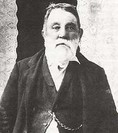I explored the possibility because
someone else suggested it two pages back: none other than the eminent Judge Roy Bean, the Law West of the Pecos:
Judge Roy Bean wrote: Spending cash on large-ticket items isn't as simple as it sounds, either - unless you're connected to some other criminal enterprise who is willing to help you get around the factoring issue. For a percentage, of course.
One has to wonder if these two yahoos were "connected" to certain resourceful fellows.
Yes: it could be as simple as two schmucks running a grift too long and their luck ran out. Nice and tidy. I hope that the victims see a little something out of this mess, and that the con men spend their few remaining years in a cell with a big drooling fella named Bubba.
Given the entire situation, however, there are a number of odd questions raised by the operation and the "leaseback" schemes as a whole. First, the specific scenario of the grift. These guys did not have a history of criminal behavior, though one could say insurance salesmen are legalized grifters. Yet NASI (and its corporate predecessor, ATM Holdings) functioned precisely according to a pattern which can be seen in every prior "ATM leaseback" scheme. They dived in and followed the script.
Where'd they come up with the idea? Spontaneously, on their own? Doubtful; they don't seem to have the imagination. Copied it from news reports of other ATM leaseback scheme busts? Weird, because every one of them ended with the principals in jail, which they could certainly anticipate by the large number of highly-publicized busts and prosecutions. Why would you want to end up in jail? Or was it presented to them, laid out as a sure-fire plan, a no-lose proposition-- "sold" to them in the same devious way they in turn "sold" the ATM contracts?
Second, the rat-on-a-treadmill situation of the latter part of the scam. Even given the real situation as we know it now, there was still a
lot of work involved. Wishner the accountant may well have kept eight sets of books, but juggling 2500 versions of reality, falsifying 30,000 sets of paperwork, dummying up phony individual spreadsheets and reports and making sure 2500 people received checks every month is a full time job. Gillis: hustling people at seminars all over the country, giving suckers the pitch at yacht clubs, dodging suspicious investors and representatives, prowling through phone books to find real ATM locations to use as cut-outs for NASI, doubling and redoubling his desperate search for more suckers as the monolith grew -- again a LOT of work for a guy who probably thought NASI was his own personal 401-K.
Observer here used Bernie Madoff as an example of an individual who just kept it up because he didn't want people to be mad, or disappointed, or whatever. First off, I cannot imagine his sons & workers were that naïve. More importantly, the size of the investments Madoff handled was not the sort of money people like to lose. Jail is the least of one's worries. If a client can afford to bet a half million bucks, or a million, or $10,000,000 on something, one can certainly afford 50 G's for a one-eyebrowed thug named Mahroot to break a couple of arthritic kneecaps. That's a far more direct method of collecting a debt than a strongly-worded email or dropping dime to the authorities. (So I don't buy into the "poor embarrassed little old man who did it all by himself and didn't want to be embarrassed" take on Mr. Madoff.)
Thirdly, the official description and the dismissal here of the "boilerplate" phrase (which is something which had not even come up when I wove my fanciful tale of other hands involved, thanks to the eye-opening hint by Judge Roy Bean). That's a legal document, signed by and attested to under oath by the US Attorney(s). It is the basis for all further action against Gillis and Wishner. If there are elements of it which are untrue-- that there are no "... others known and unknown to the United States Attorney" -- then the document hands the scam artists & their attorneys a procedural Out. "It wasn't Gillis and Wishner, they were just pawns. It was those
others that did it-- and the US Attorney knows who they are!" Or, conversely, "The document contains falsified and inaccurate information, with at least a half dozen lies. The US Attorney's office knows there are no others involved, yet stated there were directly in the charge. The entire document is suspect." That sheds doubt on the entire charge.
And it actually
is a tersely-worded document, without a surfeit of legal-ese. Boilerplate or not, it specifically and repeated mentions "... others known and unknown to the United States Attorney," which means at the very least NAS's working salespeople and cooperative brokers, possibly their spouses & children-- or the "certain resourceful fellows" to whom the honorable Judge Bean alluded.

